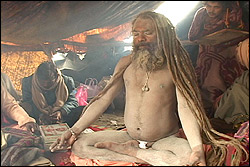Five thousand years before Jesus roamed the Earth, yogis practiced their discipleship in the Himalayas, wearing nothing but loincloths in the snow, eschewing worldly possessions, building holy fires, and fasting as they pondered the world’s mysteries. This ascetic sect of Hinduism reportedly has 13 million followers today, and they’re just as extreme, albeit marginal, in India (their main country of practice).
How does a 7,000-year-old way of life remain intact in our modern times? That’s the obvious question for documentary filmmaker Paula Fouce to address, but she fails to answer it or provide any historical context for a Western, non-Hindu audience. Instead, the film puts a universalist gloss to its bizarre subjects—because we’re all just looking for happiness, right, just like at Burning Man?—with cheesy pop music (augmented by sitars) and beatifically smiling yogis.
These holy men (or babas) do indeed cover their naked bodies in ash. Among them we meet guru Shiv Raj Giri as he guides his 14-year-old disciple, Santosh Giri, on the holy path, which includes descending on bare feet through the Himalayas to the Ganges. The boy, after three years of following his guru, performs his first initiation rite (similar to baptism): He has his head shaved and enters the Ganges, symbolically leaving behind everything he knew in his former life.
This seems pretty mild and reasonable compared to the tapas, or bizarre austerities, that other yogis willingly suffer. Raman Giri, or “Standing Baba,” has chosen to stand for 12 years, even in his sleep, while another opted to hold his right arm up for 12 years. We also meet a yogi hauling a jeep down a busy street with his penis. Why? “No penis control, no holy man,” he explains, and later adds with pride: “[The police] have arrested me many times.” Other interviews with babas and their followers are dubbed into English, not subtitled, and I can only imagine what might have been lost in translation.
These traveling bands of holy men converge at the Kumbh Mela festival, held every 12 years and also the subject of the doc Short Cut to Nirvana: Kumbh Mela that screened here in April. En route, the cinematography profoundly captures the snowcapped Himalayas and neighboring trails, dotted with greenery. These serve as unspoken sanctity, considering that the first yogis thousands of years ago also followed the same actual path. If only Fouce had shot more scenes like this one. No camera control, no filmmaker. (NR)







